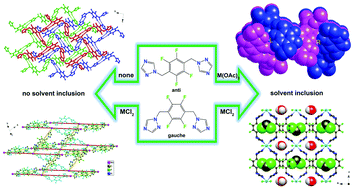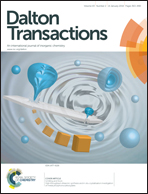Fluorinated metal–organic frameworks of 1,4-bis(1,2,4-triazol-1-ylmethyl)-2,3,5,6-tetrafluorobenzene: synergistic interactions of ligand isomerism and counteranions†
Abstract
A fluorinated bis(triazole) ligand, 1,4-bis(1,2,4-triazol-1-ylmethyl)-2,3,5,6-tetrafluorobenzene (Fbtz), was applied to coordinate with a series of MnII, CoII, FeII, and CuII ions, respectively. In comparison with its nonfluorinated analogue 1,4-bis(1,2,4-triazol-1-ylmethyl)benzene (btx), Fbtz is able to build six novel metal–organic frameworks by acting as a versatile bridge combining with the terminal chlorides (1–5) or acetates (6) ligands. The solid-state crystal structures of 1–6 are studied by single-crystal X-ray crystallography to form the following structures: 3D polymers [M(Fbtz)2Cl2]n (1: M = Mn, 2: M = Co), 1D double chain polymers {[M(Fbtz)2Cl2]·CH2Cl2·xH2O}n (3: M = Co, x = 1; 4: M = Fe, x = 2), {[Cu(Fbtz)2Cl2]·4H2O}n (5), and a 1D double-stranded helical polymer {[Cu2(Fbtz)(OAc)2]·2H2O}n (6). Conformations of Fbtz in 1–6 can be tuned as a result of varying the anions or solvent system, which ultimately form a series of novel coordination frameworks with different supramolecular architectures. The antibacterial activities of all complexes are investigated. Complexes 4 and 5 show a wide range of bactericidal activities to Gram positive (B. subtilis and S. aureus) and negative (E. coli and P. fluorescence) bacterial strains. The synergistic interactions of ligand isomerism and counteranions have profound effects on the supramolecular networks and properties.


 Please wait while we load your content...
Please wait while we load your content...